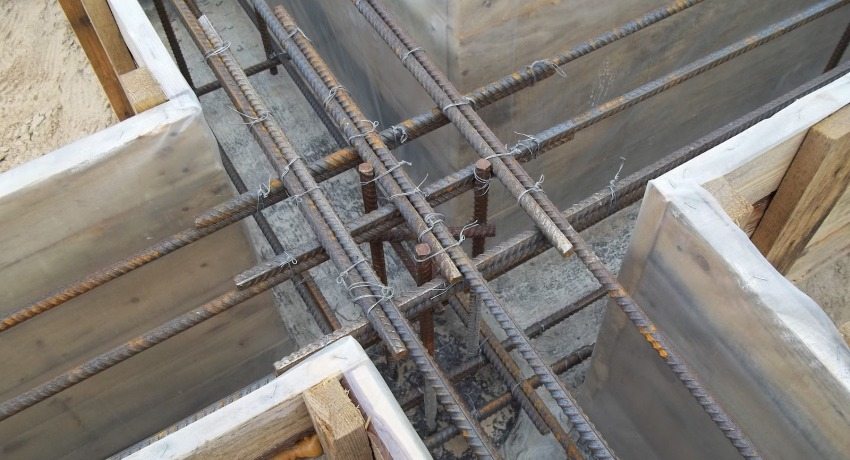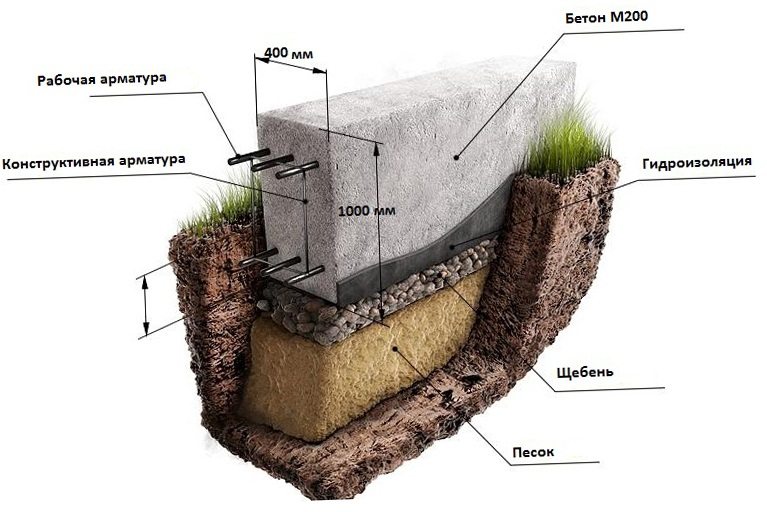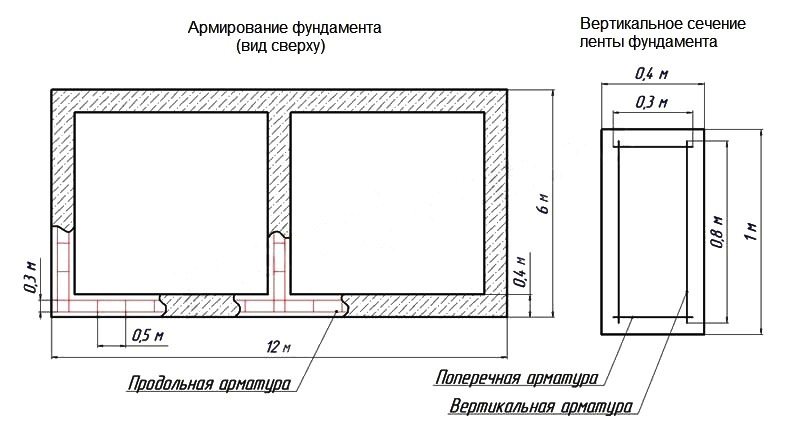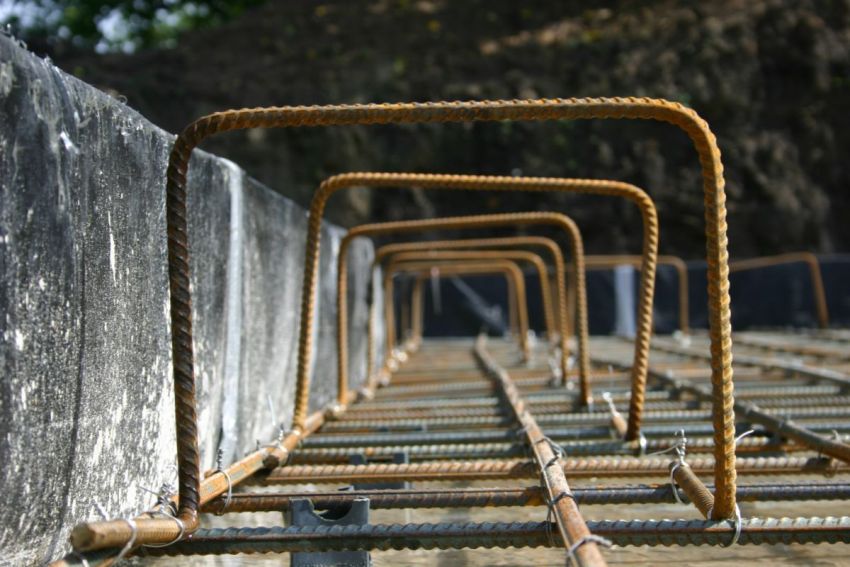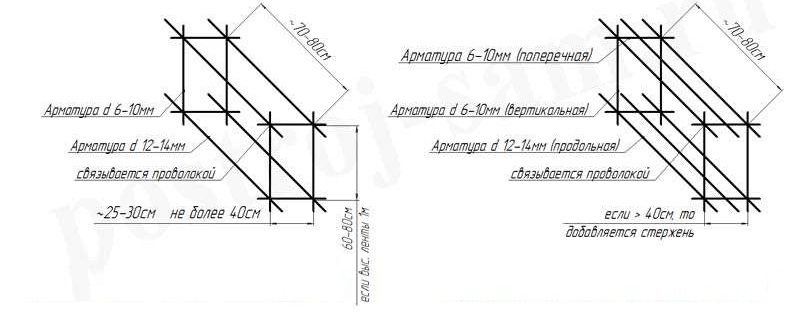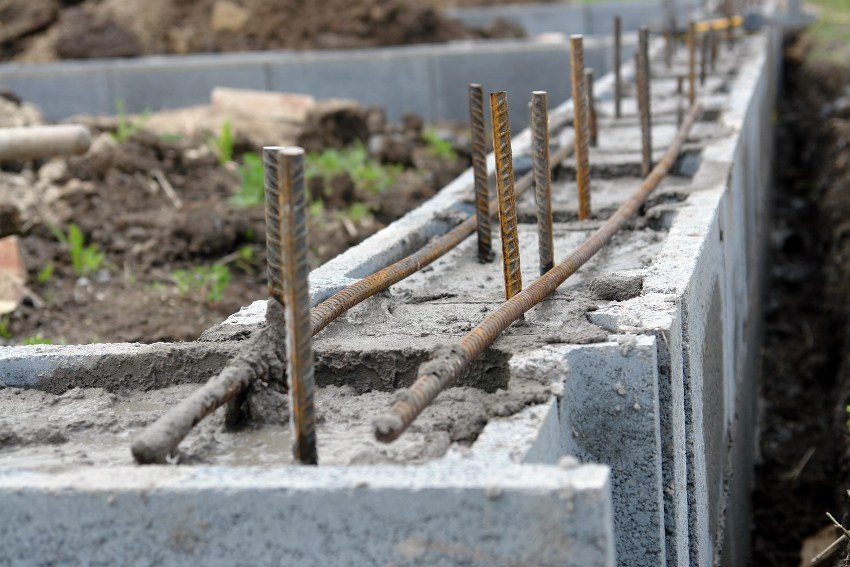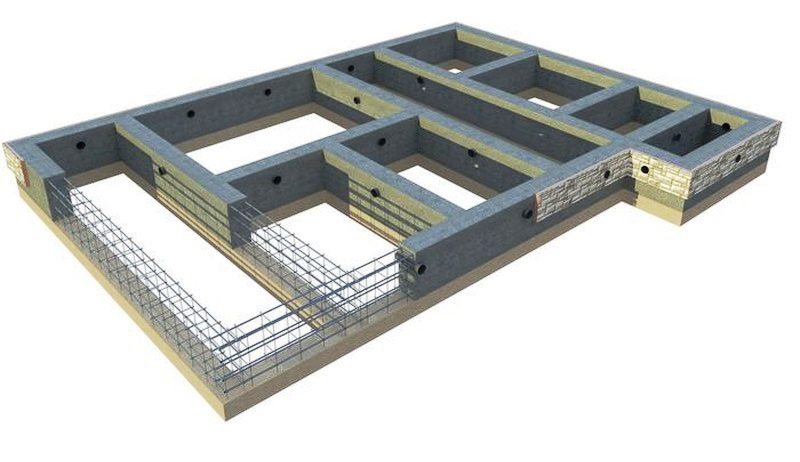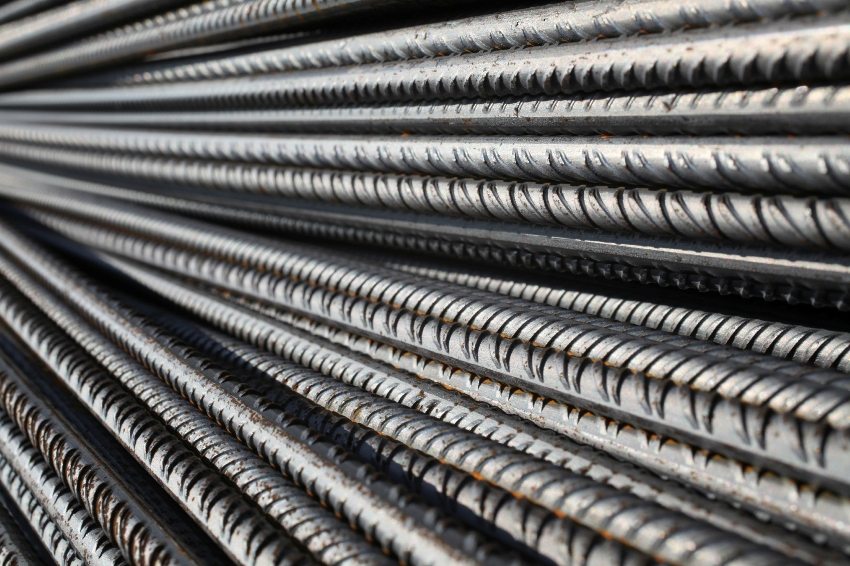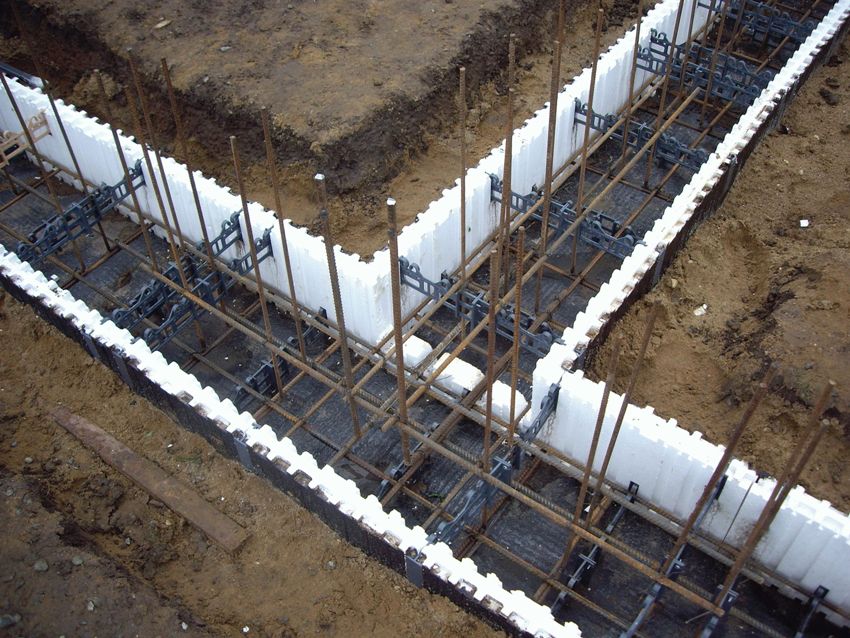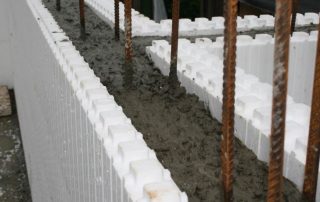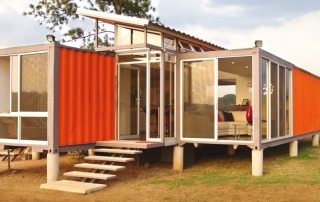The calculation of reinforcement for the foundation occurs already at the design stage and is its most important component. It is produced, taking into account SNiP 52-01-2003 in matters of choice reinforcement class, its quantity and cross-section. Reinforcement of monolithic structures is carried out in order to improve the tensile strength of the concrete structure. After all, unreinforced concrete can collapse when the soil swells.
Content
Calculation of reinforcement for a slab-type foundation
The slab foundation is used for the construction of cottages and suburban housing, as well as other buildings without a basement. This base is a monolithic concrete slab, which is reinforced with a bar in two perpendicular directions. The thickness of such a foundation is more than 20 cm, and the mesh is knitted both from above and from below.
Related article:
Column foundation with your own hands: step by step instructions. Calculation, cost of work. Shallow columnar foundation, frame house foundation, bathhouse foundation, photo and video.
First determined with the type of bar fittings... For a slab monolithic foundation, which is performed on solid, dense and non-porous soils with a very low probability of horizontal shear, it is possible to allow the use of a ribbed reinforcing bar with a diameter of 10 mm, class A-I. If the soil is rather weak, heaving or the building is designed on a slope, the reinforcement must be taken with a thickness of at least 14 mm. The vertical ties between the bottom and top row of mesh will be sufficient to use a smooth 6mm A-I rod.
The material of the future walls of the building is also very important. After all, the load on foundation has significant differences in frame, as well as wooden houses and brick buildings or aerated concrete blocks... As a rule, for light structures it is possible to use a reinforcement bar with a diameter of 10-12 mm, and for walls made of bricks or blocks - at least 14-16 mm.
The gaps between the rods in the reinforcing mesh are usually about 20 cm in the longitudinal as well as in the transverse direction. This circumstance assumes the presence of 5 reinforcing bars per 1 meter of the length of the foundation wall. Intersections of perpendicular rods are tied together with a soft wire using a device such as Crochet hook fittings.
Helpful advice! If the volume of construction is very large, then a special gun can be purchased for tying reinforcement. It is capable of automatically tying bars together at a very high speed.
An example of a real calculation
Suppose that we need to calculate the reinforcement for the foundation of a private house made of lightweight aerated concrete blocks. It is planned to be installed on a slab foundation, which has a thickness of 40 cm.Geological survey data indicate that the soil under the foundation is loamy with medium heaving. House dimensions - 9x6 m:
- since we conceived a sufficiently large thickness of the foundation, we will need to pour two horizontal grids into it. The block structure on medium-loamy soils requires a diameter of 16 mm and ribbing for horizontal bars, and vertical bars can be smooth with a thickness of 6 mm;
- to calculate the required amount of longitudinal reinforcement, take the length of the longest side of the foundation wall and divide it by the lattice pitch. In our example: 9 / 0.2 = 45 thick reinforcing rods, which have a standard length of 6 meters. We calculate the total number of rods, which is equal to: 45x6 = 270 m;
- in the same way, we find the number of reinforcement bars for transverse bundles: 6 / 0.2 = 30 pieces; 30x9 = 270 m;
- multiplying by 2 we get the required amount of horizontal reinforcement in both grids: (270 + 270) x 2 = 1080 m;
- vertical ligaments have a length equal to the entire height of the foundation, that is, 40 cm. Their number is calculated by the number of perpendicular intersections of longitudinal rods with transverse ones: 45X30 = 1350 pcs. Multiplying 1350x0.4, we get a total length of 540 m;
- it turns out that for the construction of the required foundation you will need: 1080 m of A-III D16 bar; 540 m of bar A-I D6.
Helpful advice! In order to calculate the mass of all fittings, you must use GOST 2590. According to this document, 1 running meter. Rebar D16 weighs 1.58 kg and D6 0.22 kg. Based on this, the total mass of the entire structure: 1080x1.58 = 1706.4 kg; 540x0.222 = 119.9 kg.
For the construction of reinforcement, knitting wire is also required. Its quantity can also be calculated. If you knit with an ordinary crochet, then about 40 cm will go to one knot. One row contains 1350 connections, and two - 2700. Therefore, the total consumption of wire for knitting will be 2700x0.4 = 1080 m. In this case, 1 m of wire with a diameter of 1 mm weighs 6.12 g. So its total weight is calculated as follows: 1080x6.12 = 6610 g = 6.6 kg.
How to correctly calculate the need for reinforcement for a strip foundation
The features of the strip foundation are such that its rupture is most likely in the longitudinal direction. Based on this, the need for reinforcement for the foundation is calculated. The calculation here is not particularly different from the previous one, which was done for the slab type of foundation. Therefore, the thickness of the bar can be 12-16 mm for longitudinal fastening, and 6-10 mm for transverse and vertical fastening. When strip foundation choose a step of no more than 10-15 cm in order to avoid longitudinal rupture, since the load in it is much greater.
For example calculate the foundation tape type applied to a wooden house. Suppose that its width is 40 cm and its height is 1 m. The geometrical dimensions of the structure are 6x12 m. The soil is sandy loam heaving:
- in the case of a strip foundation, the device of two reinforcing meshes is mandatory. The lower one prevents the physical rupture of the monolithic tape during soil subsidence, and the upper one when soil heaving;
- the optimal one seems to be a grid step of 20 cm. Therefore, for the correct arrangement of a tape of such a foundation, 0.4 / 0.2 = 2 longitudinal rods in both layers of reinforcement are needed;
- for a wooden house, the diameter of the reinforcing bar is taken 12 mm. To perform a two-layer reinforcement of the longest sides of the base, you need 2x12x2x2 = 96 m of a bar. The short sides require 2x6x2x2 = 48 m;
- for the crossbars, we take a 10 mm rod. Its laying step is 50 cm.
The perimeter of the building: (6 + 12) x 2 = 36 m. Divide it by a step: 36 / 0.5 = 72 reinforcing cross bars. Since their length is equal to the width of the foundation, the total need is 72x0.4 = 28.2 m; - for vertical ties, the D10 bar is also applicable. Since the height of the vertical component of the reinforcement is equal to the full height of the foundation (1 m), the required amount is determined by the number of intersections.To do this, multiply the number of transverse rods by the number of longitudinal ones: 72x4 = 288 pcs. For a height of 1 m, the total length will be 288 m;
- that is, to perform a full-fledged reinforcement of our strip foundation, it is necessary: 144 m of a rod A-III D12; 316.2 m bar A-I D10.
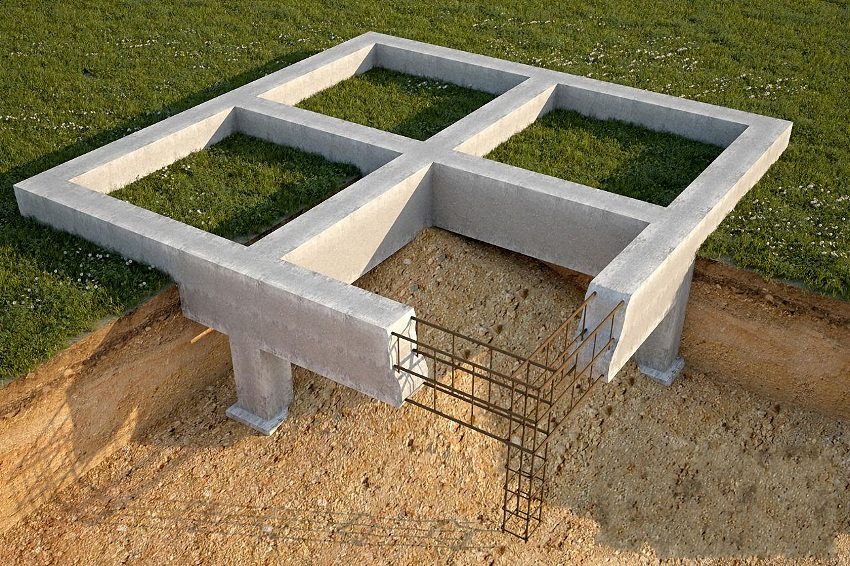
Reinforcement columnar foundation
Helpful advice! In accordance with the same GOST 2590, it is possible to determine the mass of all reinforcement based on the fact that 1 r.m. the D16 bar has a weight of 0.888 kg; D6 - 0.617 kg. Hence the total mass: 144x0.8 = 126.7 kg; 316.2x0.62 = 193.5 kg.
The examples of the calculation of reinforcement for the foundation will help you navigate the needs of materials in any case. To do this, you just need to substitute your data in the formulas.
Foundation reinforcement (video)
